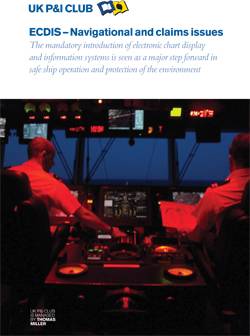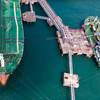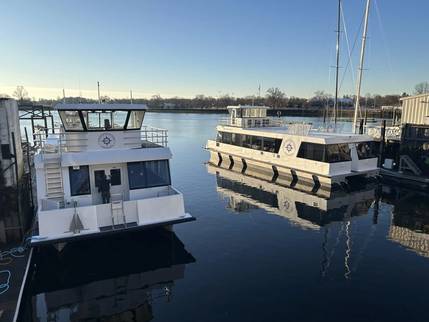UK P&I Club: Concerns about ECDIS
The UK P&I Club recently completed a series of three short articles which provide a user friendly guide to the mystery surrounding electronic chart display and information systems (ECDIS). These have now been consolidated into a 16-page booklet "ECDIS - Navigational and claims issues" that is available in hard copy from the Club or as a .pdf file from the club's website. While the booklet is not really intended for navigators, it should, the Club believes, be of great value to anyone in shipping who needs to be aware of what ECDIS is and the implications of any ECDIS-associated errors and oversights.
All three articles can be downloaded individually or in the 16-page combined format from the Loss Prevention section of the UK P&I Club website http://www.ukpandi.com/loss-prevention/lp-reports.
With the amendments to SOLAS Chapter V Regulation 19 governing the statutory introduction of ECDIS now being adopted from 1 January 2011, the 'ticking time bomb' associated with the ECDIS mandating process has now taken on a level of greater urgency with the shipping fraternity ultimately coming to the end of its breath holding exercise.
As with the introduction of previous mandatory requirements to fit equipment such as Radar, VDR or AIS systems onboard commercially operated vessels, many technical managers will now be faced with the task of acquiring full compliance with the ECDIS carriage regulations at the lowest possible capital expenditure. For many owners' fleets, this will be quite complicated since not only is there is a lot of training that still needs to be undertaken, this training needs to be type-specific. Within a fleet, there will probably be ECDIS systems from more than one manufacturer and this will have various implications, not the least of which will be a restriction on which deck officers can serve on which ships. The first LP News in this series was an all-encompassing introduction to ECDIS and dealt with the fundamentals such as 'what is (and isn't) ECDIS?', the general training obligations relating to the use of ECDIS as laid out under the provisions of the STCW 95 and ISM codes, the implementation dates by ship type and size, and the attitudes of Flag States and Port State Control. It concludes with a very valuable aid: a guide to the acronyms associated with ECDIS.
ECDIS: Asset or a Liability?
The second article in the series brings LP News and the UK P&I Club onto home territory as it considers the operational aspects of ECDIS and the intrinsic function that electronic chart and navigation systems have to play in the commercially operated ship of the future. As Karl Lumbers, a Director of Thomas Miller P&I Ltd, Managers of the UK P&I Club, explains, the mandatory requirement and introduction of ECDIS is seen by the regulatory bodies guiding the shipping industry as a major step forward in safe ship operation and protection of the environment. However, Lumbers points out that the transition to electronic navigation and the operation of a paperless bridge is being viewed differently by a significant part of the shipping community, which sees it meaning increased operational costs of new equipment and additional training requirements. More worryingly, Lumbers points out: "It is also becoming increasingly evident that far from reducing risk, ineffective operation of complex ECDIS systems resulting from poor management practices or training can actually increase the risk of incidents such as collision and grounding with the interface between computers extenuating the so called 'human element' reported as causative in almost every marine casualty. "Automation of traditional manual navigational tasks has been observed as delaying the opportunity for error detection and recovery, allowing a navigational single point failure to develop undetected into a single point catastrophic failure, ultimately resulting in an incident."
Given these facts, Lumbers believes that it is important to highlight and publicise the importance of establishing sound and effective ECDIS practices: "Only by establishing such practices can an owner expect to reap the potential benefits of ECDIS, namely the reduction of both management costs and navigational risks."
The article then goes into much more detail than the first did. Section headings include: 'The modern ECDIS system', which describes the various types such as retrofits - basically standalone PCs - and ntegrated bridge systems (IBS) now commonly found on newbuilds. 'Electronic charts', which addresses the confusion that surrounds the various types of chart available and the differences between them.
'Generic training' and 'Type specific training', which looks at the issues surrounding effective training and what is required to meet the mandatory requirements. Meeting the type specific requirements is proving a logistical nightmare for those owners with different manufacturers' products on different ships but who want their crews to be interchangeable. Reference is made to changes in bridge management systems with some companies adopting an airline-style 'navigator/co-navigator' arrangement. 'Passage planning' reveals the need to adopt different procedures when using ECDIS.
Finally the article comes to: 'Risk Analysis' where the UK P&I Club notes that given the increased technology available to the modern navigator, one of the conundrums must be why increased computerisation and automation has not removed, and perhaps not even reduced the potential for failure. It adds that instead of making things safer, new pathways to failure seem to have developed, centered on an initial miscommunication between man and machinery resulting in a misalignment in the reality of where the navigator thinks he is and where the automated system has actually taken him.
Research has shown that humans are poor monitors of automated systems and tend to rely more on system alarms than manual checks especially in relation to those systems which have proven themselves as highly reliable. In several casualty investigations it has been determined that automation has resulted in the navigator developing an 'operational bias' relying on the automated systems rather than the salient cues provided visually through the bridge window. Lumbers concludes: "An extensive risk assessment of ECDIS operation combined with a clear requirement of manual system checks of critical automated operations must be established within the company Safety Management System, effectively identifying operational risk and introducing control measures to reduce the effect of single point failures."
According to Lumbers, the main areas of risk when considering ECDIS operation can be identified under three main categories:
1. The equipment itself may suffer from failure (both hardware and software) including power outages, sensor input failure and potential virus infection.
2. The charts are operated under permit which may expire, charts in use not corrected up-to-date, updates not correctly applied, ENC chart coverage unavailable, requiring the system to be used in RCDS mode without the appropriate paper chart folio being available.
3. The operation of the ECDIS system onboard carried out by poorly trained crew following poor navigational practices and operational procedures such as excessive zooming or operating the chart for navigation with base information only displayed. Effective risk assessment as a critical function of implementation of electronic navigation is rarely emphasised when the transfer from paper to digital navigation is considered.
Legal Implications of Getting it Wrong
The third article in the series, released in June, is entitled 'Legal implications' and considers the legal effect of failure to meet the statutory ECDIS requirements and the effect on claims where levels of operation or knowledge of ECDIS are considered to be a factor or fundamental link in the chain of causation leading to an incident. Since it drills down into legal and insurance details, reproducing it here is not practical, especially since the article is itself quite concise despite running to over 2,400 words. However one all-important fact should be noted above all others, says Lumbers: "We believe that the use of ECDIS and the management of systems associated with ECDIS will come in for great scrutiny both by State Port Control and other regulatory bodies. Shipowners and their crews will not only have to do things right, they must be in a position to show that they are doing it right. Otherwise the threat of detention will never be far away.
"Furthermore, casualty investigators will have yet another source of information when seeking causes for incidents such as groundings or collisions and woe betide any poor owner who can't produce it."
Legal disputes are always likely to arise especially when large sums are involved. The principle aim of the commercially minded shipowner, charterer and cargo owner is of course to settle any disputes quickly and cheaply. If however a dispute cannot be resolved between the parties then the matter may be referred to arbitration or the courts for determination.
The Spy on the Bridge
In hearing disputes between two parties, arbitrators and judges rely upon the evidence presented to them to establish the facts of the case. This evidence traditionally presented by the parties in the form of both oral and written statements of witnesses and contemporary log entries and documentation has in thepast provided the basis on which to decisions have been made. This evidence sometimes requires the courts to determine conflicting statements on a particular issue in dispute. To establish the facts of the case in such situations, the judge or arbitrator has tended to rely heavily on contemporaneous evidence such as photographic, video or electronic information. In this respect, electronic equipment designed with a recording facility such as ECDIS, voyage data recorders, AIS data and even GPS have become a crucial part of legal proceedings often used to determine disputed facts. With literally hundreds of different types of electronic systems with recording facilities operating different generations of software, the recovery of this information can however be a difficult task in itself.
As this critical and at times complex procedure of electronic data recovery has been identified, it may be questioned why many ship managers, owners and operators have failed to provide clear instructions relating to the preservation of such data in the event of an incident. Critical information may be lost due to lack of knowledge in relation to the storage space or memory of the equipment in question or by the data being simply overwritten if action has not been taken for its preservation. With this in mind it seems sensible for the ship manager or owner to establish not only what electronic equipment installed on board each vessel has recording facilities, but also provide clear instructions to the master regarding the actions required to download the data and safeguard this critical evidence. Failure to preserve evidence may be viewed with suspicion and adverse inferences drawn. It is important to understand that ECDIS systems are capable of recording not only the log of events but the parameters of operation set up by the operator at the time of the incident. This electronic data may play a crucial part in the litigation process especially during the transition period from paper to electronic navigation where questions relating to the effective operation of ECDIS systems may be raised. This will mean that in the case of a collision for example where vector charts are selected and overlaid on radars having a primary collision avoidance designation, it may be possible for the officer charged with the navigation duties to reach information overload especially if layers in excess of chart base levels are selected. If this ineffective mode of ECDIS operation resulted in a target going undetected, ultimately resulting in a collision, the failure of the navigator to act in accordance with the Collision Regulations in this mode of operation may not only result in criminal charges and civil negligence actions, but may render the vessel unseaworthy with questions as to the exercise of due diligence on the part of those responsible for the management of the ship raised by cargo interests or insurers.













